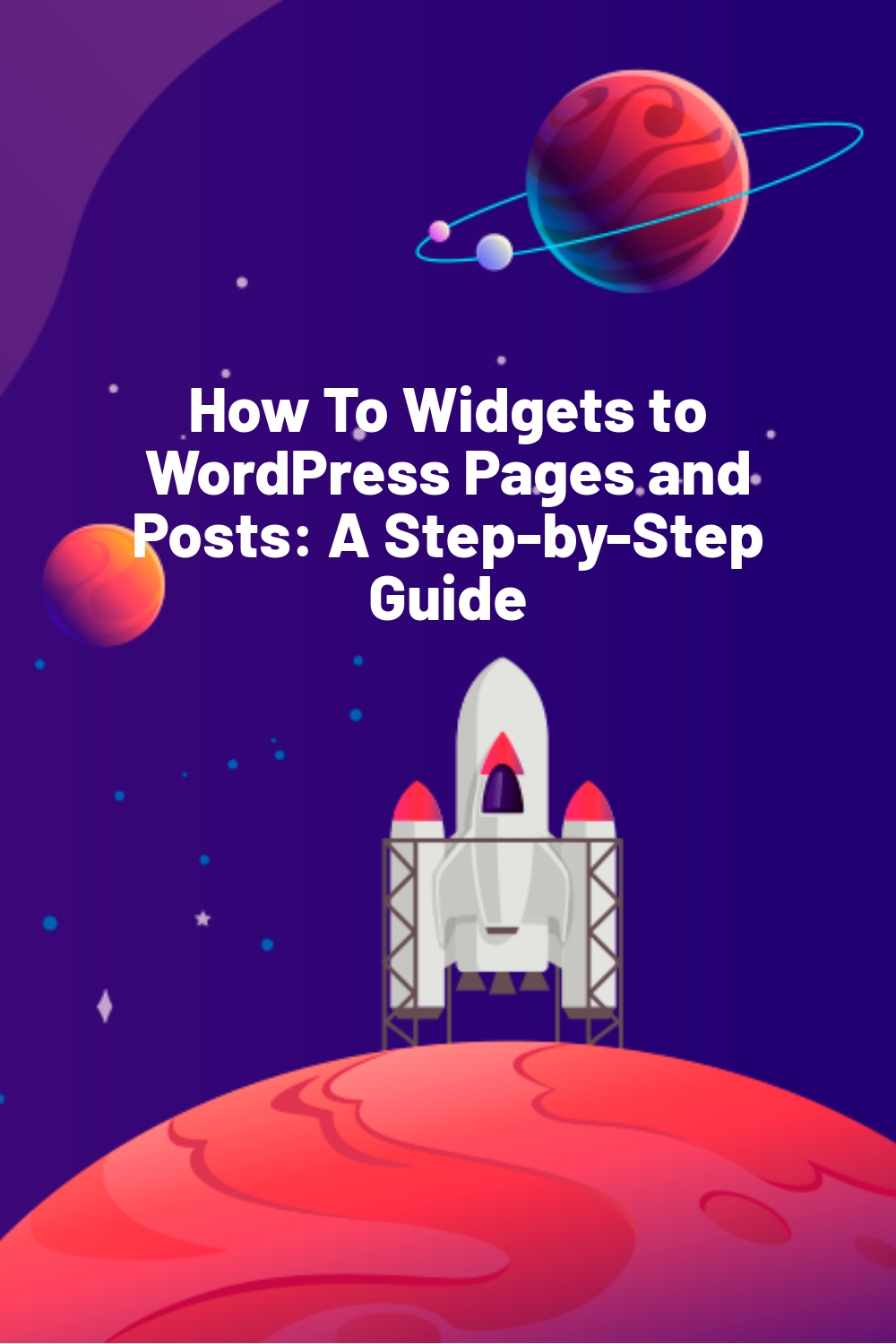WPLift is supported by its audience. When you purchase through links on our site, we may earn an affiliate commission.
How To Widgets to WordPress Pages and Posts: A Step-by-Step Guide
When you start creating a website on one of the world’s leading CMS, WordPress, you might get overwhelmed with the number of features and functionalities it offers. Moreover, you start including the call to action, biographies, and other elements to add substance to your WordPress site.
However, you forget one of the most essential elements that improve the design and offer an enhanced user experience. And what is that? WordPress widgets.
Widgets let you integrate functionality into your WordPress site in the sidebar and other widget areas without writing a single line of code. Now, the question is, how to add widgets to WordPress site? Don’t worry; here, we will provide answers to all of your questions.
In this blog, we will explain the steps to add widget to WordPress pages and posts effectively. But, before that, we will cover the basics of widgets and why you need to include them on your WordPress site.
So, let’s get started.
What are WordPress Widgets?
WordPress is intended to be a user-friendly platform for beginners. WordPress makes it simple to customize your site to meet your needs, even if you have limited technical skills and no experience with coding.
Widgets are one of the tools WordPress offers to accomplish this. A WordPress widget is a flexible component that lets you add a specific feature to your website. Widgets are an integral part of WordPress’s design and layout customizations, and they can be added to various areas of a website, such as sidebars and footer areas.
Widgets give you the flexibility to identify content you want to show on every page of your site and make sure no one misses it, making your site more than just a blog.
Why Add Widgets to WordPress Pages and Posts?
Widgets are fantastic, and many plugins will include custom widgets that allow you to do things you wouldn’t usually be able to do. Most of these extra features can only be added to the sidebar or footer of a page. Because themes only allow you to place widgets in specific areas. A widget could bring several other opportunities to your website’s pages that you may not know.
Here are some reasons you should add a WordPress widget in pages and posts.

Article Continues Below
- Improve Navigation: In a sidebar, you can add additional menus to help your users navigate that page or the entire site.
- Increase Website Traffic: Widgets help display links to other pages or posts on your website, encouraging users to explore your content and driving more traffic.
- Advertisement Opportunities: If you want to balance your user experience and ad revenue on your WordPress site, you’ll find that adding a widget to your sidebar and footer specifically for this purpose is essential.
- Extra Content: New blog posts, evergreen content, and limited-time offers are examples of additional content that may have their own pages on your site but could benefit from extra promotion to your readers. Adding these content types as widgets in a sidebar is a clever way to bring them to the forefront without making them appear cluttered.
- Customization: Widgets can be customized to match the look & feel of your website, giving you more control over the design and layout of your site.
What Kinds of Widgets are Available on WordPress?
Looking at some examples of WordPress widgets is the best way to understand their possibilities. Let’s look at eleven different types of widgets that you’ll see on WordPress sites.
Map Widget
If your company has a physical location and you want people to be able to find you quickly, a map widget on your website can help.
Navigation Widget
A navigation widget is essential to encourage visitors to move around your site. The Navigation Menu widget allows you to create a custom navigation menu in addition to your site’s main navigation menu, which you can then add to a widget area.
Recent Comment Displays
The Recent Comments widget shows the most recent comments on your site, allowing visitors to jump right to them and participate in the conversation.
Recent Post
The Recent Posts widget is one of the most popular widgets in blogs.
It allows you to show a list of your most recent posts in the sidebar or footer of every page on your site, increasing the likelihood that visitors will browse the site and read several posts.
Social Media Widget
Adding your social media feed to the sidebar or footer of your website will show visitors that you’re active on social media and encourage them to like or follow you.
Search Displays
The Search widget, preloaded with WordPress, is straightforward but extremely useful. Including this in your sidebar or header makes it easier for visitors to find information on your website.
Call to Action Widget
You can use a call-to-action widget to encourage people to take action, which is an excellent use of a widget. Your widget could be a simple button, or you could use a text widget, HTML widget, or even an image widget, all of which come pre-installed with WordPress to create something more unique.
Media Widget
Including media in your sidebar or footer will liven up your site and give visitors something to look at or interact with. The built-in Image widget allows you to display any image in your sidebar or footer, and it also allows you to turn that image into a link.
Alternatively, the Video widget lets you stream video directly into your site’s widget area from YouTube or Vimeo. It is beneficial if your site has dedicated widget areas for the home page, but it can also be useful in the footer to draw people’s attention when they reach the end of a post.
Shopping Cart Widget
If you’re using a plugin like WooCommerce to run an eCommerce store on your site, it’s a good idea to include a cart widget so users can easily navigate to their cart anywhere in the store.
If your theme includes a widget area in the header, you could put this in the sidebar where it will be easily seen or in the header for added visibility.
Login Widget
A login widget will make it easy for people to log into your site without going to a separate login page if you’re running a membership site.
Form Widget
You could include a form in your sidebar if you want people to contact you, ask questions, or subscribe to a mailing list. A login link is included in the Meta widget that comes with WordPress.
How to Add Widgets to WordPress Page and Post?
It’s time to install the widgets you need for your WordPress site once you’ve decided what kind of widgets you’ll need.
Don’t go overboard with the additions. Users are less likely to notice them if there are a lot of them. Instead, concentrate on two or three key sidebar widgets. You can put more in the footer, where they’ll be less noticeable.
Also, if your theme has any extra widget areas decide which widgets to put in them, and make sure they go with your site’s layout and design.
- To add a widget to your site, log in to your dashboard, then go to Appearance Widgets: Add a Widget.

- You’ll find a list of the default WordPress widgets here, along with a title and brief description for each. One or more designated widget areas can be found on the right, with headers (such as Sidebar or Footer) indicating their location. Depending on your theme, some widgets may already exist in these areas. Simply click and drag a new widget into a widget area.

- To remove widgets from your site, do the opposite. You can also reorder individual widgets by dragging them up or down. That concludes our discussion. You should notice the following new feature if you go to the front end of your site:

How to Add Widget to WordPress Page and Posts using Plugins?
While you can add widgets to your website using native WordPress functions, the default settings prevent you from displaying (or disabling) these widgets on specific posts or pages, whether you want them there or not.
Plugins can solve this problem. These custom add-ons will allow you to add widget to WordPress page and control how they appear.
1. Content Block (Custom Post Widget)

The Content Blocks feature allows you to use a shortcode to display the contents of a specific custom post in a widget or the content area.
If you’re using standard WordPress text widgets to display content in different areas of your template, only users with administrator access can edit it. If you want non-administrator accounts to be able to change the widget content, you can use this plugin to grant them access to the custom posts that contain the widget content.
This plugin creates a custom post type called ‘content block.’ You can use the title to describe the contents and widget position of the content block or display it on the page. It’s worth noting that these content blocks can only be viewed within the context of the page.
Pros
- You can even put them in a widget using the featured image feature.
- The WPML Multi-Language plugin is compatible with the Content Blocks plugin, and the correct language is displayed in the widget area automatically.
- You can leverage built-in shortcode functionality to include the Content Blocks in posts and pages.
Cons
- Not often updated
Price
- FREE
Steps to Add Widget
- Navigate to Appearance and click Widgets.

- Click and drag the Content Block title to the desired location under Available Widgets. In this case, we’ll use Sidebar B for the website’s right side. For more information on Content Block locations, see the Page Layout article.
- Select the title of your content blocker to the desired Widget location
- Choose the display options you want. You can choose to show the Content Block Title or the Featured Image. You can also make the Featured Image the Background Image, as well as move it to the right or left.

- Under Widget Context, you will need to select the pages or type the URL for the pages you would like the Content Block to display on (or not to display on).

- Then click save.

Get Content Blocks (Custom Post Widget)
2. SiteOrigin Widget Bundle

Installing a plugin usually only provides a single widget that performs a single task. However, the SiteOrigin Widgets bundle includes a variety of useful widgets such as a Google Maps widget, slider widgets, button widgets, call-to-action widgets, and more. Every blog should have this plugin installed.
The SiteOrigin Widgets Bundle is so much more than a set of widgets. It’s a base on which you can build widgets in a fraction of the time. It has advanced form building, data handling, and templating capabilities. The Widgets Bundle’s core takes care of everything so you can concentrate on creating beautiful widgets.
Even if you don’t want to make your own custom widgets, the Widgets Bundle is simple to extend in other ways. For all of our existing widgets, you can create custom templates, styles, and form fields. Creating a custom style for the button widget that matches the look and feel of your theme is one example use case.
Pros
- Among the well-featured WordPress page builders, SiteOrigin is by far the oldest. With age comes a fully built plugin that has evolved over time to include all of the basic features needed to create a functional website.
- Simple image widget with massive power.
- Display a grid of images. Also useful for displaying client logos.
Cons
- It is not always the case that free is the best option. SiteOrigin has a very basic user interface with drab colors. Instead of custom icons for the builder, some of its widgets use WordPress icons. Its functionality receives much attention, rather than balancing it with the user interface.
- Typically, the SiteOrigin plugin is downloaded without the widget bundle. You must first download and install the widget bundle before creating or editing web pages.
Price
- FREE
Steps to Add Widget
- Install the SiteOrigin Widgets Bundle from PluginsAdd New, then search for SiteOrigin Widgets Bundle using the search form in the top right corner of the page. Install and activate the software.

- Go to PluginsSiteOrigin Widgets to find the Widgets Bundle dashboard once activated. You can view all widgets, enabled widgets only, or disabled widgets only using the tabs at the top of the page. Locate the widget you want to allow and click the Activate button.

3. Custom Sidebars – Dynamic Sidebar Widget Area Manager
It is another plugin that helps you add a widget in WordPress sites efficiently. The plugin lets you manage and replace sidebars and other widget areas with custom sidebars.Here, you need to carry out custom sidebar configurations and select the widgets you want to showcase on the site. It allows you to dynamically show the custom widgets on a page, post, category, post type, or archive type.
Pros
- It is user-friendly and straightforward to navigate.
- You can create custom sidebars and widget areas as per your need.
- It saves your time by enabling you to showcase specific content on pages & posts without doing any coding.
- Get excellent support from the team.
Cons
- Some users find the settings of the plugins confusing.
- The use of too many custom widgets can slow down the website speed.
Price
Free
Steps to Add Widget
- First of all, install and activate the plugin.
- Go to appearance -> Widgets. Here, you would see an area known as Custom Sidebars.
- You get an option to make a custom sidebar or drag and drop the built-in widgets into the section known as Theme sidebars. Here, you have an opportunity where to display the widget (in the sidebar or footer).
- Tap on the down arrow of the respected widget, and click visibility.
- Click on the + button and decide whether the widget can be viewed on particular pages & posts.
- Save the entire widget settings.
- Preview the content to view all the changes.
4. Sidebar & Widget Manager for WordPress
It is one of the most popular plugins you can rely on to add a sidebar & widget in WordPress site. The plugin gives you complete control over the page content, sidebars, layouts, and widgets.
It offers drag-and-drop widgets in various sidebars and customizes their place on the pages or posts as needed.
Besides this, the plugin offers various other features like WPML plugin support, OTW content sidebars, easy & intuitive administration, and more.
Pros
- It has an intuitive interface that allows you to manage sidebars and widgets.
- It lets you customize the sidebar and widgets, along with changing the widgets’ position, size, and style.
- It offers flexibility in terms of placement of widgets, allowing users to add them to different areas of their website, such as the header, footer, or sidebar.
Cons
- The support team is not up to the mark.
- The plugin might not be compatible with other themes and plugins.
Price
The plugin costs $34 and comes with lifetime updates and 6-month support from OTWthemes.
Steps to Add Widget
- Download and activate the plugin.
- Go to the appearance -> widgets.
- Tap the Set Visibility button and choose pages where widgets should be presented.
You can even change the position of the widgets on pages & posts by building custom sidebar widgets.
- Initially, navigate to the Pages section.
- Create a layout or choose a default option available from the dropdown menu.
- Simply drag and drop all the sidebars which you wish to exhibit.
- Click on the preview to look at the modifications you have made.
Wrapping Up
In the end, as a site owner, you can utilize these widgets in WordPress pages and posts to enhance the functionality and aesthetic appeal of your site. Following the simple steps outlined in this guide, you can easily customize your website and offer a unique experience to your visitors. Whether you want to add a search bar, social media icons, or a custom menu, WordPress widgets make it easy to add these features to your website without coding knowledge.
With some experimentation and creativity, you can create a website that looks great and provides a flawless user experience. So, start exploring with various widgets available and take your WordPress website to the next level.











Great post! I can definitely see lots of use coming from this.
It does seem like the AMR Shortcode plug in might be the best. It’s simple, but not everything needs to be overdone and complicated in my opinion.
Sounds great, but is there anywhere we can see examples of what the finished posts/pages look like with the various widgets in action?(Or did I miss something?)
I never knew half off the stuff in this post. It is going to be useful as i continue to tackle the world of website building.
I still have a lot to learn even with something as simple as wordpress.